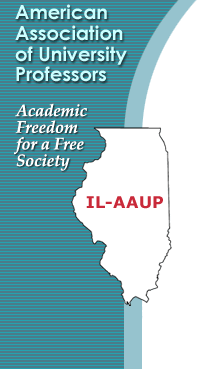Home | IL Academe | About IL AAUP | Conference Corner | Calendar | Services | Committees | Contact Us | Grants | Reports | Links
 |
 |
 |
Destroying Our Seed Corn By Ken Andersen A myriad of issues deserve attention -- local, national, global: the dangers of pension changes threatening hiring of new faculty; the underestimated monetary perils that confront Illinois; threats of a downturn in the national economy due to state and federal cutbacks in employment; external threats to everything from the price of gasoline, explosive unrest in Northern Africa and the Middle East to natural disasters linked to global warming that we can no longer avert. But in looking to the future I see a threat that we can manage if we have the will. Facing national and state financial limitations we are rather systematically destroying our seed corn. We are cutting back on funding education at the level required to be competitive in the knowledge based world economy of the future. We must ensure the competitiveness of our students in that future if the nation or state is to prosper. I have been astonished at the number of articles in magazines, newspaper columns, business and industry, saying we are falling behind in the education of the next generation whether in elementary, secondary or higher education and calling for greater effort to reverse that trend. We are doing very well at developing student self-esteem. American students report they are doing very well in math, reading etc. Yet recent comparative studies show we are lagging behind many countries by more than one decile. Our students spend fewer days in school than students in other developed countries. We have shorter school days and shorter school years. James Warren in the New York Times Chicago Section of March 13 noted Chicago’s school day was only five and a half hours long, shortest of any of the 40 largest districts in the nation. A Houston student gets four more years of schooling in terms of total K-12 class time. What of teacher quality? Tony Wagner of Harvard argues that students need three skills to compete in a knowledge economy: ability to do critical thinking and problem solve, communicate effectively, and to collaborate. Nations such as Finland and Denmark where students stand out in these skills draw teachers from the top third of college graduates. We do not. In many states the goal is to cut the number of teachers, their pay and benefits while significantly increasing class size to manage shortfalls in the budget. Imagine a class of 60 students in elementary school. Will such changes attract top graduates to teaching? How should we allocate student aid? Private for profit institutions reap a high proportion of federal scholarship funds. Some spend comparatively high amounts on recruiting students who do not graduate and are left with significant student debt. You cannot use bankruptcy to escape student debts because they follow you forever and the interest grows. Listen to Suze Orman! The federal government has begun an investigation of abuses suspected at some private for profit colleges. State budget constraints have moved many states to reduce funding for higher education. Now the student not the state often carries the major cost of attending a public college. There are unlimited factors to blame for the growing lack of competitiveness of students. Certainly parents are responsible in part for the failure of students to maximize their potential in elementary and secondary schools as is the class status of many parents and students. Students: recent reports note the decline in hours college students actually study. One report found the average college student showed no increase in critical thinking skills after two years of college while earning very high grade point averages. So teachers are also at fault in the failure of students to maximize their potential. Money is not the only resource needed to ensure the competitiveness of our students in a global economy. But it is an essential resource. State after state cuts educational funding. The public increasingly blames teachers for everything from pension shortfalls to holding cushy jobs. Doesn’t every college faculty member mow lawns at 3pm on Tuesday or Wednesday and spend only 6 to 9 hours a week teaching, if that? Many, many aspects of the educational system need improvement: teacher quality, instructional methodology, length of the school day and term, a commitment by all parties to maximizing student learning. While the public may have a distrust of many governmental functions, most people recognize and support the need for a high quality educational system. Individuals disagree about how to achieve that goal. But most would prioritize adequate funding of education over many of the concerns that occupy the attention of state and national legislators, such as continuing the low tax rate for the wealthiest among us. Legislators will not sufficiently address the need to prepare for the future by ensuring our students get the education they need. Just as the farmer must protect his seed corn to get a good future crop, so we must protect ours. |
|